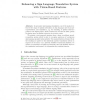Free Online Productivity Tools
i2Speak
i2Symbol
i2OCR
iTex2Img
iWeb2Print
iWeb2Shot
i2Type
iPdf2Split
iPdf2Merge
i2Bopomofo
i2Arabic
i2Style
i2Image
i2PDF
iLatex2Rtf
Sci2ools
100
Voted
GW
2007
Springer
2007
Springer
Enhancing a Sign Language Translation System with Vision-Based Features
Abstract. In automatic sign language translation, one of the main problems is the usage of spatial information in sign language and its proper representation and translation, e.g. the handling of spatial reference points in the signing space. Such locations are encoded at static points in signing space as spatial references for motion events. We present a new approach starting from a large vocabulary speech recognition system which is able to recognize sentences of continuous sign language speaker independently. The manual features obtained from the tracking are passed to the statistical machine translation system to improve its accuracy. On a publicly available benchmark database, we achieve a competitive recognition performance and can similarly improve the translation performance by integrating the tracking features.
Related Content
| Added | 07 Jun 2010 |
| Updated | 07 Jun 2010 |
| Type | Conference |
| Year | 2007 |
| Where | GW |
| Authors | Philippe Dreuw, Daniel Stein, Hermann Ney |
Comments (0)

